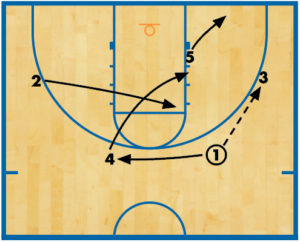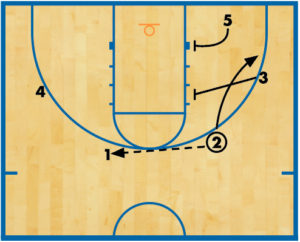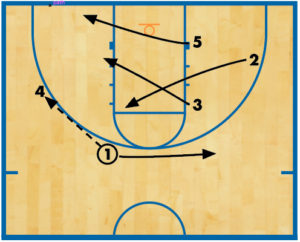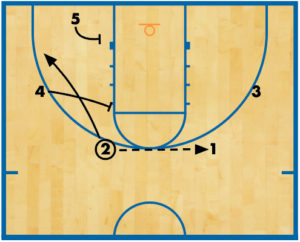Emptying the zone offense toolbox
A continuity offense to throw zone defenses off their game
Attacking from the post and “short-corner,” screening the backside of the zone, utilizing a cutter through the zone to find open seams and extending the zone from one side of the floor to the other with ball reversal and offensive continuity. All of these are useful and effective strategies that every basketball coach has in their toolbox when confronted with a zone defense.
 However, there are not many zone offenses that have found a way to use each of these into one coordinated attack. The following continuity offense was developed for just that purpose.
However, there are not many zone offenses that have found a way to use each of these into one coordinated attack. The following continuity offense was developed for just that purpose.
In addition to all of the above benefits, this zone offense also gives the coach the luxury of keeping his or her post player in the short-corner and off the perimeter. This limits the need for the post to handle the basketball, except when using the short-corner option to attack the basket.
The offense allows for the point guard to remain at the top during its continuity movement. This places them in perfect position for defensive transition when a shot is taken. It also makes use of a team’s forwards on both the perimeter, for ball reversal and in the mid-post area.
The final major benefit is that the offensive coach can keep the most effective perimeter-player in a set position that uses their skills as both a cutter through the zone and a perimeter shooter. This is where you want your best decision maker and playmaker. They will regularly get opportunities to make plays in the paint and open outside shots on the weak-side of the zone.

This is not a stagnant zone offense with perimeter players standing around attempting to beat the defense with rapid ball movement. Instead, it is an offense that makes use of both ball and player movement. It requires proper floor spacing while allowing for several scoring options with which to confront a zone defense.
The following diagrams outline this zone offense’s player movement and offensive continuity.
Learning the offense
DIAGRAM 1: Directly out of transition, the offense will show a four-out, one-in set with the post player on the ball-side of the floor. 1 looks to engage the top and wing defender of a 3-2 zone or the right top defender of a 2-3 zone before passing to 3.

After passing, 1 fills the weak-side top as 4 dives to the mid-post. 5 steps out to the short corner and, after these cuts are made, 2 flashes to the open high-post spot in the zone.
If the zone defense does not “bump down” its coverage on the pass to 3, either 5 in the short corner or 4 in the post should be open. On the pass and attack of the basket, typical zone rules apply. On a pass to the short corner, for example, 5 looks to score on a short jumper or baseline power move, pass to 4 diving to the basket or skip pass to 1, who would find the open gap on the weak-side.
On a pass to the post, 4 looks to score on a post move, pass to 5 diving to the basket from the short corner or a skip pass to 1, again finding the open gap on the weak side.

If the zone does “bump down” coverage to handle the wing, short corner and post, 2 cutting to the open high-post seam of the zone is likely open. If this pass is made, 2 can look to score in the lane off of a quick shot or a shot fake and drive. If the zone converges, 2 can look to pass to an open post diving or an open perimeter player spotting up.
DIAGRAM 2: If no shot opportunity presents itself for the offense, 2 steps out on top for ball reversal. As this occurs, 4 sprints from the mid-post to the opposite wing.
DIAGRAM 3: On the pass to 1, as the zone shifts and slides with the movement of the ball, 3 5 look to screen the backside of the zone as 2 fades to the new weak-side wing. The look is now for the skip pass 1 to 2 for the open shot.

This weak-side screening action often results in wide-open perimeter looks for 2 as, due to the ball-oriented nature of zone defenses, the defense’s attention is focused on the ball (often even turning its back to the weak side). The defense makes predictable slides back into the lane area with the movement of the ball on the perimeter. What occurs then is basically a “blind-screen” of these zone defenders as the ball is skipped over their heads to 2 on the wing.
DIAGRAM 4: If this scoring option is not utilized, the pass is made to 4 on the wing and the offense is reset and run to the opposite side of the floor. This is the continuity.
After passing, 1 spaces out to the opposite top spot, 2 cuts to the mid-post, 5 cuts to the short corner and 3 flashes to the high post.

DIAGRAM 5: The offense continues with 2 stepping out for ball reversal and 3 cutting out to the opposite wing.
DIAGRAM 6: On the pass to 1 for ball reversal, 4 and 5 look to screen the backside of the zone for 2 to fade to the open spot on the wing. The look is then, again, for the skip pass from 1.
If this option is not taken, the offense resets itself on the opposite side of the floor with 5 cutting to the ball-side short corner and 4 filling the ball-side mid post.
The backside screening action initially results in many open shots for 2 on the wing, but the zone will quickly attempt to adjust to this action. Because of the screening and open looks that resulted on the weak side, zone defenders either become less aggressive in recovering to the ball side, which results in the zone becoming more extended and interior options becoming more available, or the zone defenders fight hard to get through or around the weak-side screens. That results in your screeners becoming scoring options as they find the next interior zone defender to pin and post-up. In either case, the offense has made the zone defense alter its slides and adjust its movements.

The continuity of this offense is simple to teach and learn, and it provides a team with a potent offensive weapon. In one continuity offense, it places a number of the tools used as zone defensive counters at a coach’s disposal.
With proper execution, there are numerous scoring opportunities. Because of that, it’s definitely worth trying.









